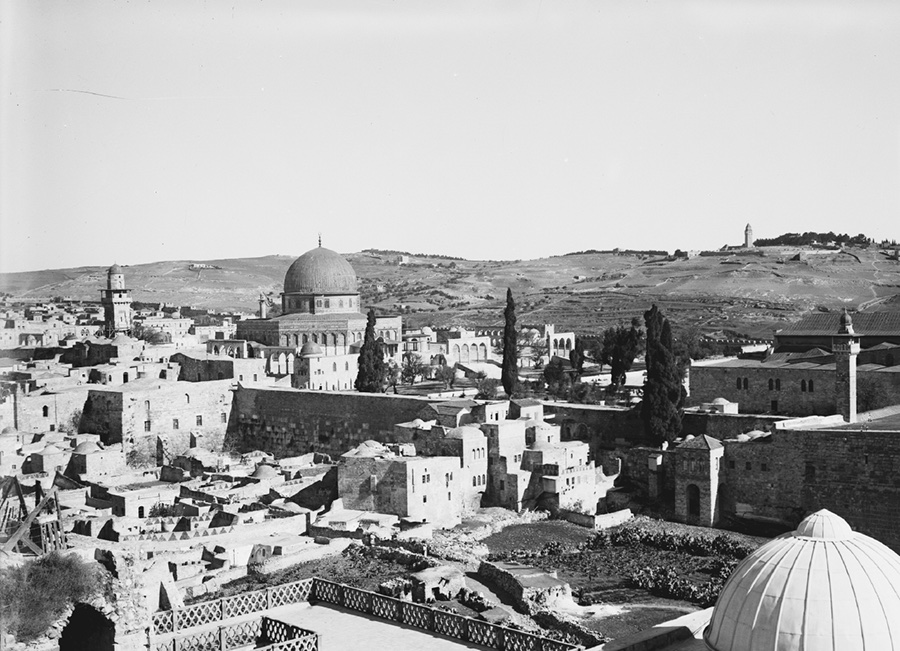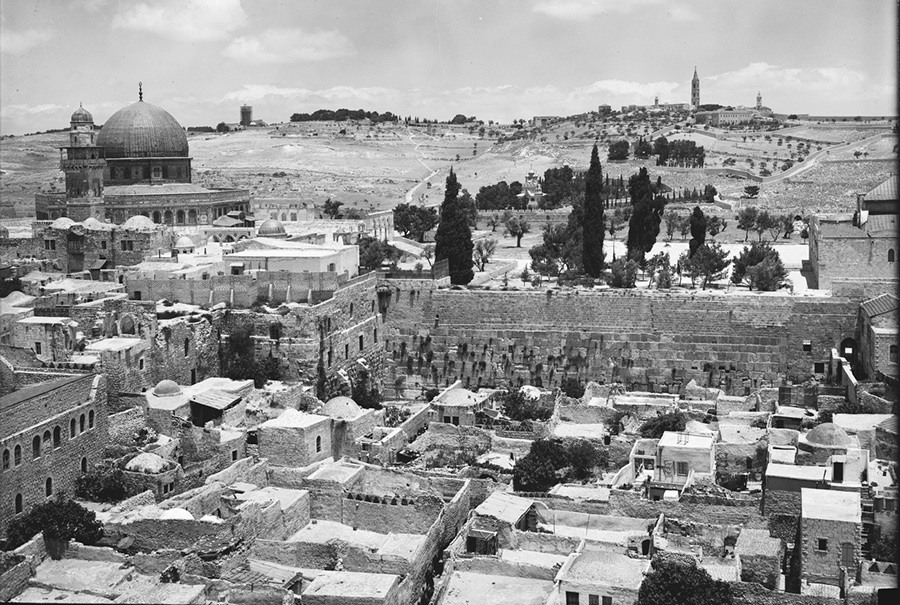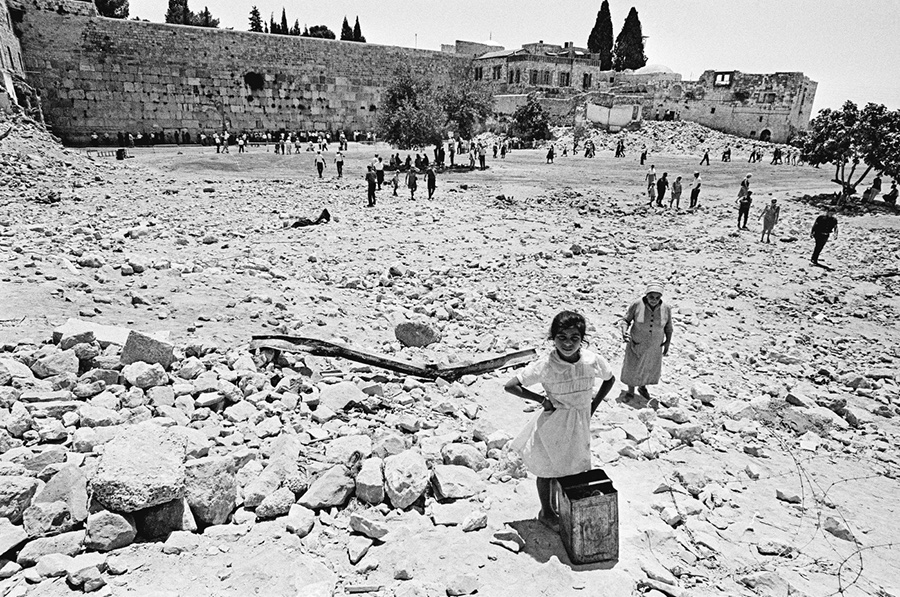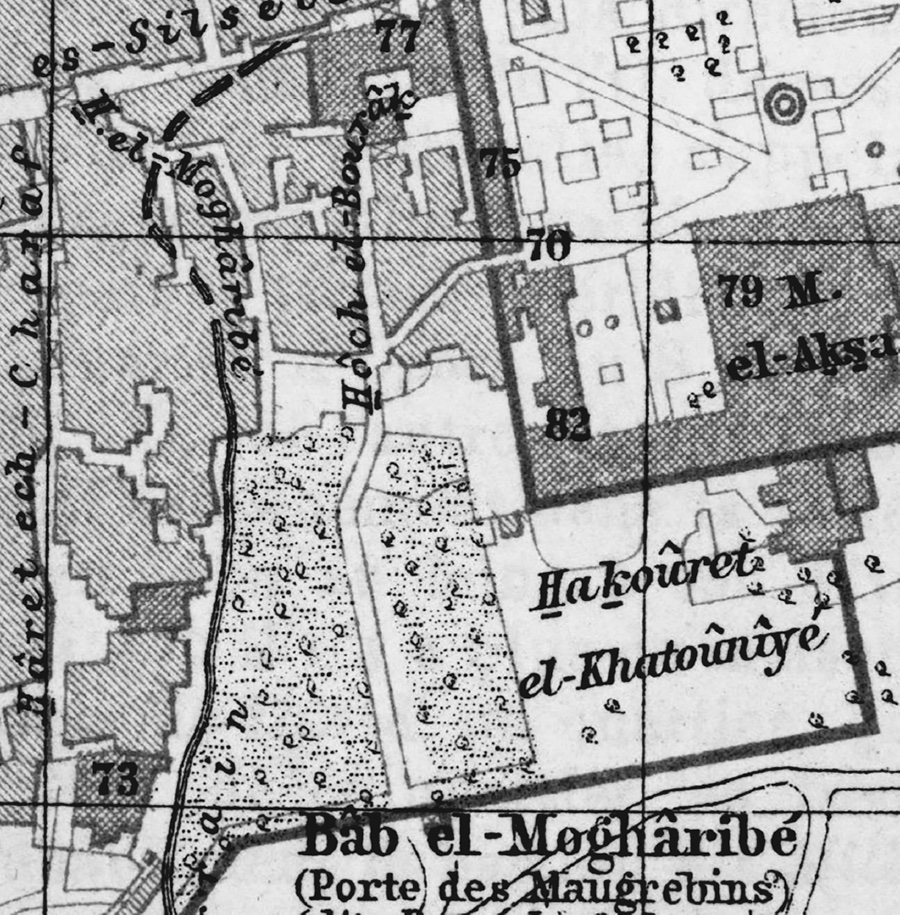There are places for history that tend to favor the face-to-face meeting of past and present, by examining documents and events differently, by seeking to hinge what has disappeared on what appears.
Arlette Farge, Des lieux pour l’histoire. Paris: Le Seuil, 1997
Saturday, 14 February 2004: Jerusalem is under a blanket of snow, as is often the case in winter in this mountain town, perched at an altitude of nearly eight hundred meters. Three days earlier—late Wednesday morning, 11 February—a 5.2 earthquake has shaken the region, causing some damage in Jericho, Jerusalem, and Bethlehem. But again, that’s nothing out of the ordinary in a region regularly hit by seismic events, sometimes of far greater magnitude.1 On this Saturday, braving the cold and snow, a few women are gathered in prayer before the Western Wall, within the perimeter set aside for women, right at the foot of the talus that borders the plaza at the southern end. By chance, there are no tourists on the embankment above the talus which leads to the Maghrebi Gate, the only access route authorized for non-Muslims to reach the Temple Mount, or Haram al-Sharif. The weather is indeed hardly conducive to strolling; it has been raining and snowing profusely for several days. Everything is quiet; only the praying and chanting can be heard, while other sounds are muffled by the snow that covers the entire landscape and gives an impression of a harmonious, cohesive, and peaceful space.
Suddenly, without warning, the talus collapses on itself, triggering the blacktop layer to cave in. Huge blocks of stone roll down into the middle of the prayer area, overturning tables and chairs, and fortunately causing no casualties. The rockslide immediately uncovers numerous vestiges, sections of wall, foundations, vaults and pilasters, demonstrably old and until now concealed by the backfill that has just collapsed. So far, none of this is particularly newsworthy, for as we know, a “land slippage” is nearly always accompanied by a “time slippage”: the Holy City, time and again destroyed and rebuilt, sits atop a multitude of overlaid archaeological layers, and when the land subsides, it brings to light chronological strata for all to see, like an open-air stratigraphic cut. But in this case, it is not an episode of biblical history or crusader legend that this accident has suddenly exposed, but a history far more recent and in many ways more combustible: that of the Maghrebi Quarter where, since the Middle Ages, there once lived several hundred inhabitants originating from Morocco, Algeria, and Tunisia—a historical neighborhood of Jerusalem that was destroyed within a few hours in June 1967, in the aftermath of the Six-Day War.
The unearthing of these vestiges was bound to rekindle the buried memory of the vanished neighborhood, as evidenced by these excerpts from the preliminary report released on 12 March 2007 by a UNESCO mission sent to the site by the World Heritage Committee to assess the impact of this collapse:
The pathway leading from the Western Wall Plaza to the Maghrebi Gate of the Haram es-Sharif is what remains of the Maghrebi Quarter, demolished by Israel in the aftermath of the six-day war of June 1967. [ . . . ] In the early 1970s, after the demolition of the Maghrebi Quarter, support walls were built on the northern and southern sides of the pathway, while a concrete structure was built over it to allow the construction of the pavement and the erection of a protective canopy. Since that time, the pathway has been the main access to the Haram es-Sharif for visitors and for the Israeli police and, since 2004, for Jewish worshippers accompanied by the Israeli police. [ . . . ] In February 2004, weakened by heavy rain and snow, the northern wall of the pathway collapsed, thus creating risks for the users. The collapse of the wall exposed the vaults of the underlying structures.2
Further on in the report, the UNESCO experts pointed out that the issue was referred to the World Heritage Committee by the officials of the Jordanian Waqfs, who considered the excavations undertaken by the Israeli authorities at the foot of the collapsed talus to be illegal under international law. If the affair escalated to this point, it is because it reawakened the trauma of the inhabitants’ expulsion and the demolition of the quarter, as explicitly noted by the Jordanians: “The Waqf stated that the entire area of the former Maghrebi Quarter and the pathway are its property and that, since 1967, it had requested the return of the keys of the Maghrebi Gate, to no avail. [ . . . ] The Waqf fears that the archaeological excavations will destroy the last remains of the Maghrebi Quarter.” The UNESCO experts conveyed their concern and demanded that the Israeli government “stop immediately the archaeological excavations,” in the conclusion of the report sent by their director-general to the secretary-general of the United Nations, Ban Ki-moon.3
Since then, the “Maghrebi Ramp” affair has become one of the recurrent points of contention between Israel and UNESCO, as the Arab members of the organization step up resolutions intended to remind all members of the “Islamic” character of this perimeter and to protect heritage deemed “endangered”—going so far as to trigger the unilateral withdrawal of the United States and Israel from UNESCO in late 2018.4 Beyond the complex geopolitical context in which it unfolded, the affair can be analyzed as symptomatic of a dramatic return of the repressed: the Maghrebi ramp, described in the 2007 report as “what remains of the Maghrebi Quarter,” functioned as a “memory keeper” allowing remembrance to reemerge like an intruder nearly fifty years after it was formed, when the ramp accidentally gave way.5 Just as a butte preserves the memory of ancient geomorphic formations abraded over time by erosion, the Maghrebi ramp indicated by its very presence that something had existed before, in place of today’s spacious Western Wall Plaza (figure 1).6 In fact, this talus, partly backfilled at the time of the neighborhood’s demolition in June 1967, was the last vestige of a vanished history, terraced and deliberately forgotten after the Six-Day War.
Although the Maghrebi Quarter of Jerusalem is effectively a “persistent stigma,” there is no denying that it is also a fragile and paradoxical remembrance, precisely because it is deprived of an established and instituted memory.7 The quarter is a buried remembrance, unformulated, unexpressed, unelaborated. It belongs to what clinical psychology calls “unspoken” or “denial,” and what we might call more commonly a “memory lapse.” Surprisingly, it turns out that the 1967 destruction is unknown to most visitors to the Holy City, and no exhaustive history of the Maghrebi Quarter has yet been published.8 Even though it was located at the very heart of the old city, amid the most sacred sanctuaries of the three monotheistic religions, a focal point of observers and diplomats the world over—or perhaps more to the point, because of all that—the history of this bit of the city, from its origins to its disappearance, has never been given the thorough longue durée examination it deserves. Although it has been logically obliterated by Israeli historiography, it is also worth mentioning that this history has not earned a place in the Palestinian national narrative either, unlike the nabka of 1948, the pivotal feature of Palestinian national identity.9 Undoubtedly because it lies largely outside the narrow scope of national identities, it makes sense that the Maghrebi Quarter of Jerusalem would remain even today one of the blind spots of the region’s historiography, including in works devoted entirely to the 1967 Six-Day War.10 In order to grasp what is at stake in this history, this initial surprise must be a starting point that at first leaves us incredulous, but which we must locate at the core of our analysis: Why has the history of the Maghrebi Quarter of Jerusalem never been written?

One reason why the history has gone unwritten is undoubtedly that it takes place in a complex space-time that is particularly tricky to untangle, and because it has been obscured by the shadow cast by the singularly cumbersome “party wall.” The Maghrebi Quarter was indeed located quite concretely “up against the Wall,” at the foot of the Western Wall (Kotel ha-Maaravi in Hebrew), kept as holy since the late Middle Ages by the Jewish communities of Jerusalem and considered today the central holy place of Judaism.11 Given that the wall’s imposing Herodian stonework is a vestige of the second Temple, destroyed by the emperor Titus’s Roman troops in the year 70 CE, we must immediately add that, from the vantage of religious representations, the history of the Maghrebi Quarter is situated not only “in the shadow of the Wall” but also in the shadow of the Temple, which makes this history all the more thorny and challenging (figure 2). It is literally “immured” in this head-to-head confrontation of stone with the Temple’s imposing party wall, and therefore must first be rescued from this stifling proximity, at least temporarily, by taking a crucial step back.
Even if it is obvious that the fate of the Maghrebi Quarter was increasingly bound up with that of the Western Wall starting in the early twentieth century, when the sanctuary was becoming a focal point for certain figures of the Zionist movement, it is nevertheless true that its history did begin before that time, and that it was not always so tightly bound to that of its famous party wall. To enable a history of the Maghrebi Quarter that is unencumbered and open, the quarter must necessarily be repositioned in the longue durée, to loosen the teleological grip forged by its tragic destiny when it was finally razed during the night of 10 to 11 June 1967 to make way for an expansive plaza in front of the Western Wall, now more monumentalized than ever (figure 3). As in Greek tragedy, it is the death of the Maghrebi Quarter that in the end absorbed the meaning of its life: its disappearance is what finally reduced to silence the story of its very existence. And the few rare studies published on the subject speak solely of its destruction. It is therefore against this imperative, at once tragic and teleological, that a genuine history of the Maghrebi Quarter, of its life and death, must be constructed.12

This history begins in 1187, when Saladin (Salah ad-Din), victorious conqueror of Jerusalem, launched an ambitious policy to repopulate and reurbanize the Holy City, particularly in its southern outskirts, largely abandoned during the Crusades era.13 In the late twelfth century—with help from one of his closest lieutenants, the Sufi mystic of Andalusian heritage Sidi Abu Madyan, and at the instigation of his eldest son, al-Afdal Ali—Saladin had an array of religious endowments established, whose purpose was to welcome, house, and care for pilgrims of Maghrebi origin. This gesture of generosity, well suited to the imperial ambition of the prestigious founder of the Ayyubid dynasty, was matched by the construction of a new oratory on the Haram al-Sharif intended for Maghrebi pilgrims, as well as a Koranic school or madrassa devoted to the teaching of Maliki law, the dominant school of jurisprudence in the Maghreb. Nothing was unprecedented here, since Jerusalem has always been rebuilt and repopulated by the contribution of exogenous populations wishing to settle as close as possible to monotheism’s sacred sanctuaries. What is more surprising is that this assembly of waqfs (religious endowments) was still functioning in the Ottoman era, the British Mandate, and the Jordanian period . . . and right up to the moment when the quarter was demolished in June 1967.

Over nearly eight centuries, despite the vagaries and ravages of time, these endowments that soon merged under the prestigious banner of Sidi Abu Madyan performed the function corresponding to their founder’s intent: in the early 1960s, the Abu Madyan stewards were still distributing bread and meals to the inhabitants of the quarter during Ramadan, donating warm clothing and coal in winter, paying burial costs for the neediest among them, purchasing lamp oil for lighting the mosque, and paying the regular salary of an employee in charge of maintenance. Meanwhile, Moroccan, Algerian, and Tunisian pilgrims kept coming in greater and greater numbers as transport modernized and allowed for a more convenient stopover in Jerusalem on the way to or from Mecca. The Waqf Abu Madyan, was effectively perpetuated. Not only did it resist the ravages of time and the onslaught of challengers; it persisted. It achieved what it set out to do, and what its founders intended it to do: last and endure. This long-term history, open to the winds of empires, migrations, and the Mediterranean, deserves to be narrated and interrogated, with recourse to the longue durée as a constituent part of its truth—for “territorial constructions are above all consolidated time,” to quote Marcel Roncayolo’s felicitous phrase.14
If the history of the Maghrebi Quarter has yet to be written, it is undoubtedly because of how long it has remained in the shadow of the Western Wall, but also because it is a particularly emotive and painful history, one that has pinned history as a discipline “up against the wall,” summoned to simultaneously mobilize all its heuristic and ethical standards: tact, composure, and method. That is first because this history immediately runs the risk of being drowned in the toponymical controversy over what to call the Wall. As the “Wailing Wall” or “Wall of Tears,” according to Christian tradition, it is believed to bear witness to Jewish sorrow at the destruction of the Temple in the year 70. As Kotel ha-Maaravi, or the “Western Wall,” it has been venerated by the Jews since the sixteenth century as a vestige of the second Temple of Jerusalem. As “al-Buraq” for the Muslims, it commemorates the nighttime journey of Muhammad, who is believed to have tethered his winged horse (al-Buraq) at this site before praying with the prophets of the ancient alliance (figure 4).
Myth versus myth, memory versus memory, religious tradition versus religious tradition: even within the halls of UNESCO, the controversy focused on the Wall’s verticality and its toponymy, erasing along the way the horizontal history, both urban and civic, of the Maghrebi Quarter that had once spread at its feet.15 To make such a history possible, a simple but categorical methodological principle must be adhered to: historians are not in the business of purveying proof of authenticity, and they must resolutely refuse this function so often foisted upon them, particularly in Jerusalem. On the presumption that “collective memory is essentially a reconstruction of the past,” and that it unceasingly adapts “the image of earlier facts to beliefs and spiritual needs of the present,” to cite Maurice Halbwachs’s robust warning, the historical discipline must not compromise itself within these vying memories, but must still take charge of them in its own way, from a fully assumed outside position, making these processes of memory-building objects of history in their own right.16

It is fascinating, for example, if not to say mind-boggling, to compare the traditionally agreed-upon etymology of the place name “Kotel ha-Maaravi”—the Western Wall as the ultimate vestige of the second Temple, located on the western side, a tradition certified in certain rabbinical midrashim since the fifth century CE but pinpointed at that location only in the middle of the sixteenth century—with the one posited in the early 1950s by the Islamic scholar Louis Massignon. Having observed that the first settled communities of Muslim Maghrebis in this perimeter (in the late twelfth century) precede by three centuries the Jews’ assigning of sanctuary status to this portion of the wall (in the sixteenth century), he suggests that the place name perhaps originally designated the “Wall of the Westerners” or the “Wall of the Maghrebis,” since the term “Maghrebi” (“Maaravim” in Hebrew) does indeed mean “Westerners,” as seen from the Middle Eastern perspective, especially since certain sources seem to indicate that this sanctification of the Wall corresponds in time with the arrival in Jerusalem of “maaravim” Jews expelled from Spain in the late fifteenth century.17 History as a discipline would stand to gain little by attempting to settle this controversy. Rather, it should confine itself to stating that only the way a place is used can truly provide the basis for legitimizing any appropriation. But controversy can provide food for thought, to better understand the degree to which the persistence of Maghrebis in Jerusalem can also undoubtedly be explained by the paradoxical power of this Western Islam nestled in the heart of the holy places of the East.
Recognition of this entanglement of memories also contributes to understanding why the issue has become increasingly displaced and elusive in the contemporary era: “Western” Muslim pilgrims settled at the foot of a “Western” wall made a sanctuary by communities of “Western” Jews, dislodged in 1967 by the rise of the Zionist project. There is a kind of Larsen effect in this story, a feedback loop that literally disorients our contemporary representations; and this is perhaps also what has rendered it inaudible, illegible, and in a certain way therefore invisible. To disentangle this saturated memory loop, we have to get back to the fundamentals of the discipline and recall that the processes of memory construction and legitimizing are not the product of discursive or ideological strategies alone, but also of much more concrete and embodied procedures: legal action, real estate investment, and day-to-day grassroots social welfare. The history of the Maghrebi Quarter and its long persistence are precisely products of these strictly history-related analytical categories.18
This compendium of actions has left traces in a disparate and scattered set of archival holdings, a feature that may well provide a further explanation, of a purely operational order, as to why no one to date had attempted a synthesis of the the Maghrebi Quarter’s history. Long concealed within the recesses of miscellaneous documentation, this history today can only be one of disclosure—a diachronic narrative, but also the history of the single-minded quest for its scattered archives, sometimes nonexistent, often all but inaccessible. To achieve this, we cannot make do with the mere factual information contained within; sustained attention must also be devoted to the documents’ form and materiality, their locality, and the context of their production, circulation, and conservation—all of which bears witness to the many transnational connections that weave together this quarter’s history, but also to the strictly heuristic issues of this “piecemeal” history, so often disjointed and thwarted, but a history “nevertheless,” partly hobbled by the always significant gaps in its documentation (figure 5).19 Displaying this documentary archipelago does “allow for a glimpse” into the historian’s craft, but it must not impede the emergence of narrative flow and historical chronology. I will therefore endeavor to organize this reconstitution respecting whenever possible the sequencing of documentation as it emerges or evades discovery, to weave together the chronicle of the Maghrebi Quarter of Jerusalem and that of its archives.
Let us attempt a brief sequential overview. The local waqf archives housed at Abu-Dis in East Jerusalem tell an “Islamic” story of the Maghrebi Quarter, and testify to the endowment’s judicial foundation since its medieval origins, but also to the consistent effort to adhere to its initial objectives. The Ottoman archives, housed in Istanbul, are a reminder that control of religious endowments was a fundamental leveraging tool in the service of the imperial government, particularly in a strategic city like Jerusalem, at the center of mid-nineteenth-century power dynamics: stewards were appointed or dismissed, accounts were approved or rejected, petitions submitted by the quarter’s inhabitants were carefully reviewed. And in the end, an imperial history of the Maghrebi Quarter begins to take shape. The archives of the Jerusalem municipality for the years 1890 to 1910 demonstrate, in turn, that the neighborhood was well integrated into the rest of the city; that it was well maintained, well lit, and regularly cleaned; and that it enjoyed the same modernization efforts that were observable in the rest of the city at that time.20 All these archival holdings have to be patiently collected and connected to arrive at an overall vision of the history of the Maghrebi Quarter of Jerusalem from its origins until the early twentieth century, because each contains an irreducible measure of its truth, and because this documentary dispersal is itself inherent to its history.
1. Salamon 2004. https://www.emsc-csem. org/Doc/Salamon_11022004.pdf/.
2. “Report of the Technical Mission to the Old City of Jerusalem,” UNESCO, WHC-O7/31.COM/INF.7A.2, World Heritage Committee, 31st session, Christchurch, New Zealand, 27 February–2 March 2007; https://www.un.org/unispal/ document/auto-insert-206780/.
3. “Address by the Director-General of UNESCO Mr. Koichiro Matsuura,” UNESCO, WHC-O7/31.COM/INF.7A.2, World Heritage Committee, 31st session, Christchurch, New Zealand, 19 March 2007.
4. Goetschel, Lemire, and Potin 2018; Anatole-Gabriel 2016.
5. Emek Shaveh, “Why Is the Mughrabi Ramp a Political Issue?” 9 September 2014; http://alt-arch.org/en/why-is-the-Mughrabi -ramp-a-political-issue/.
6. René Maheu (director-general of UNESCO), “Israël et l’UNESCO,” Le Monde, 21 November 1974, pp. 1–3: “En détruisant un quartier de structure médiévale qui faisait partie intégrante du tissu urbain traditionnel de la vieille cité [ . . . ], il est certain que l’aspect du site au voisinage de la célèbre porte des Maghrébins a été profondément altéré” (By destroying a neighborhood of medieval structures that made up an integral part of the traditional urban fabric of the old city, [ . . . ] it is certain that the appearance of the site neighboring the famous Maghrebi Gate has been profoundly altered).
7. Halbwachs 1925.
8. No bibliography is available in French, apart from Lemire and Salenson 2018; and Lemire 2017. In English, there is one largely deficient article: Abowd 2000. In Arabic, monographs focused especially on the administration of religious endowments present in the quarter include Al-Alami 1981; Civic Coalition for Defending the Palestinian’s Rights in Jerusalem 2008; Aramin and Rifai 2011; Al-Maghribi 2014; and Al-Jubeh 2019a. In Hebrew, there is a brief article on the legal framework of the Waqf Abu Madyan in Weigert 1990; and a brief notice devoted to the demolition of the quarter, in Bahat 2016–17.
9. Khalidi 2003.
10. Oren 2003. One of the most striking examples of this odd avoidance is that, out of this book’s 460 pages, the destruction of the Maghrebi Quarter is mentioned only incidentally, in two lines (p. 307).
11. Kloetzel 1935; Ben-Dov, Naor, and Avner 1983; Storper-Perez 1989; Saposnik 2008, 2015; Ricca 2010; Cohen-Hattab 2017, 2018.
12. Filiu 2008.
13. Hillenbrand and Auld 2009; Rosen-Ayalon 2002: 101–8; Loiseau 2016: 257–59.
14. Roncayolo 1990: 20.
15. Gilles Paris, “UNESCO: Les raisons du retrait des États-Unis et d’Israël,” Le Monde, 13 October 2017.
16. Halbwachs 1971: 150.
17. Massignon 1951: 73–120; Yerushalmi 1985: 38–39; Peters 1985: 528–29 (“The Western Wall”). On Jewish Maghrebis in Palestine, see R. Cohen 2005. On the French colonial history of the term “Maghreb,” see Hannoum 2021.
18. Algazi 1994.
19. Stoler 2009.
20. Lemire 2016.